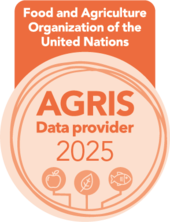Concentraciones de glifosato y 2,4-diclorofenoxiacético en granos, hojas y suelos en cultivos de cacao (Theobroma cacao L.) en la región San Martín, Perú
DOI:
https://doi.org/10.57188/manglar.2024.001Resumen
El objetivo de la investigación se centró en identificar parcelas cacaoteras con presencia de glifosato y 2,4-diclorofenoxiacético; así como cuantificar estas moléculas en suelos, hojas y granos fermentados secos de cacao en 16 zonas productoras de cacao (Theobroma cacao L.) en la región San Martín. Las muestras se analizaron mediante cromatografía líquida de ultra alta resolución (UHPLC). Encontrándose concentraciones de glifosato en suelos entre 0,1751 y 0,5925 ppm; por su parte en hojas de cacao se encontraron concentraciones entre 0,0015 y 0,2639 ppm. En granos secos fermentados de cacao se obtuvieron valores de glifosato entre 0,0427 y 0,5518 ppm. En lo referente a valores de 2,4-diclorofenoxiacético, los suelos presentaron concentraciones desde 0,2248 hasta 0,7201 ppm; mientras que en hojas se reportaron valores entre 0,0011 y 0,3307 ppm. En granos secos de cacao la cuantificación fue desde 0,0708 hasta 0,6491 ppm. Se estableció que existen contrastes significativos (p < 0,05) entre las cantidades de glifosato y 2,4-diclorofenoxiacético en suelos, hojas y granos secos de cacao. Afinando que los valores de glifosato y 2,4-diclorofenoxiacético encontrados en granos secos de cacao en el 93,75% de las parcelas superan los LMR que dicta la NTS No 128-2016/MINSA/DIGESA que es de 0,1 ppm para dichos analitos.
Descargas
Referencias
Alcántara-de la Cruz, R., Cruz-Hipólito, H. E., Domínguez-Valenzuela, J. A., & De Prado, R. (2021). Glyphosate ban in Mexico: potential impacts on agriculture and weed management. Pest Manag Sci, 77, 3820-3831. https://doi.org/10.1002/ps.6362
Ancayay Leal, V. (2022). Determinación de la presencia del ácido 2,4 diclorofenoxiacético en cacao en grano (Theobroma cacao) para exportación. [Tesis de posgrado]. Universidad Estatal de Milagro, Guayas, Ecuador.
Bataillard, D., Christe, P., & Pigeault, R. (2020). Impact of field-realistic doses of glyphosate and nutritional stress on mosquito life history traits and susceptibility to malaria parasite infection. Ecol Evol., 27(10-11), 5079-5088. https://doi.org/10.1002/ece3.6261
Bernal Barreto, E. M. (2020). Implementación de una técnica de cromatografía líquida de alta eficiencia para detección de glifosato en suelos, lixiviados, tomate (Solanum licopercycum) y albahaca (Ocimum basilicum) [Tesis de pregrado]. Universidad Santo Tomás, Colombia.
Boakye, R. G., Stanley, D. A., & White, B. (2023). Honey contamination from plant protection products approved for cocoa (Theobroma cacao) cultivation: A systematic review of existing research and methods. PLoS ONE, 18(10), 1–23. https://doi.org/10.1371/journal.pone.0280175
Brucha, G., Aldas-Vargas, A., Ross, Z., Peng, P., Atashgahi, S., Smidt, H., Langenhoff, A., & Sutton, N. B. (2021). 2,4-Dichlorophe-noxyacetic acid degradation in methanogenic mixed cultures obtained from Brazilian Amazonian soil samples. Biodegra-dation, 32(4), 419–433. https://doi.org/10.1007/s10532-021-09940-3
Cano García, A., Ochoa Fuentes, Y. M., Maldonado Ortega, V., Ceballos Ceballos, A. G., Linares Márquez, P., Cerna Chávez, E., & Lafón Terrazas, A. (2022). Determinación y cuantificación de residuos de plaguicidas en suelo y agua en pastizales del noreste de México, hábitat del perrito de la pradera mexicano. Revista Mexicana De Mastozoología, 12(1), 33–48. https://doi.org/10.22201/ie.20074484e.2022.12.1.347
Carles, L., Martin-Laurent, F., Devers, M., Spor, A., Rouard, N., Beguet, J., Besse-Hoggan, P., & Batisson, I. (2021). Potential of preventive bioremediation to reduce environmental contamination by pesticides in an agricultural context: A case study with the herbicide 2,4-D. Journal of Hazardous Materials, 416, 125740. https://doi.org/10.1016/j.jhazmat.2021.125740
Casado, J., Brigden, K., Santillo, D., & Johnston, P. (2019). Screening of pesticides and veterinary drugs in small streams in the European Union by liquid chromatography high resolution mass spectrometry. Science of The Total Environment, 670, 1204-1225. https://doi.org/10.1016/j.scitotenv.2019.03.207
Chávez-Dulanto, P. N., Thiry, A.A.A., Glorio-Paulet, P., Vögler, O., & Carvalho, F. P. (2021). Increasing the impact of science and technology to provide more people with healthier and safer food. Food and Energy Security, 10, e259. https://doi.org/10.1002/fes3.259
Delmonico, E., Bertozzi, J., Souza, N., & Oliveira, C. (2014). Determination of glyphosate and aminomethylphosphonic acid for assessing the quality tap water using SPE and HPLC. Acta Scientiarum Technology, Volume 36. 513-519. https://doi.org/10.4025/actascitechnol.v36i3.22406
Eta, H. C., Eremi, E. O., Idiku, F. O., & Eta, J. N. (2023). Pesticide Use, Management Practices and Perceived Effects on the Health of Cocoa Farmers in Cross River State, Nigeria. African Journal of Food, Agriculture, Nutrition & Development, 23(6), 23558–23575. https://doi.org/10.18697/ajfand.121.22785
European Parliament. (2019). Commission Regulation (EU) 2019/1791 amending Annexes II, III and IV to Regulation (EC) No 396/2005 of the European Parliament and of the Council as regards maximum residue levels for 1-decanol, 2,4-D, ABE-IT 56, cyprodinil, dimethenamid, fatty alcohols, florpirauxifen-benzyl, fludioxonil, fluopyram, mepiquat, pendimethalin, picolinafen, pyraflufen-ethyl, pyridaben, S-abscisic acid and trifloxystrobin in certain products. (Text with EEA relevance). Brussels, Belgium.
Freisthler, M., Robbins, R., Benbrook, C., Young, H., Haas, D., Winchester, P., & Perry, M. (2022). Association between increasing agricultural use of 2,4-D and population biomar-kers of exposure: findings from the National Health and Nutrition Examination Survey, 2001–2014. Environmental Health, 21. https://doi.org/10.1186/s12940-021-00815-x
Gaón Sarmiento, E. B. (2013). Efecto y persistencia de glifosato en el cultivo de cacao en Sucumbíos. [Tesis de pregrado]. Universidad Técnica del Norte, Ibarra, Ecuador.
Gandhi, K., Khan, S., Patrikar, M., Markad, A., Kumar, N., Choudhari, A., Sagar, P., & Indurkar, S. (2021). Exposure risk and environmental impacts of glyphosate: Highlights on the toxicity of herbicide co-formulants. Environmental Challenges, 4, 100149. https://doi.org/10.1016/j.envc.2021.100149
González, M., Meza, D., Valentina, Martínez, N. V., & Pedroza, M. R. (2023). Glyphosate impact on human health and the environment: Sustainable alternatives to replace it in Mexico. Chemosphere, 340, 139810. https://doi.org/10.1016/j.chemosphere.2023.139810
Hintze, S., Sameh, Y., Hannalla, B., Guinchard, S., Hunkeler, D., & Glauser, G. (2021). Determination of chlorothalonil metabolites in soil and water samples. Journal of Chromatography A, 1655, 462507. https://doi.org/10.1016/j.chroma.2021.462507
Hisyam Zainudin, B., Salleh, S., Syukur Yaakob, A. y Mohamed, R. (2021). Comprehensive strategy for pesticide residue analysis in cocoa beans through qualitative and quantitative approach. Food Chemistry, 368, 130778. https://doi.org/10.1016/j.foodchem.2021.130778
Islam, F., Wang, J., Farooq, M. A., Khan, M. S., Xu, L., Zhu, J., Zhao, M., Muños, S., Li, Q.X. y Zhou, W. (2018). Potential impact of the herbicide 2,4-dichlorophenoxyacetic acid on human and ecosystems. Environ Int, 111, 332-351. https//doi.org/10.1016/j.envint.2017.10.020
Martínez-Ruiz, E. B., & Martínez-Jerónimo, F. (2018). Exposure to the herbicide 2,4-D produces different toxic effects in two different phytoplankters: A green microalga (Ankistrodesmus falcatus) and a toxigenic cyanobacterium (Microcystis aeruginosa). Science of the total environment. 619–620, 1566-1578. https://doi.org/10.1016/j.scitotenv.2017.10.145
Mohamed, R., Hisyam Zainudin, B. y Syukor Yaakob, A. (2020). Method validation and determination of heavy metals in cocoa beans and cocoa products by microwave assisted digestion technique with inductively coupled plasma mass spectrometry. Food Chemistry. 303, 125392. https://doi.org/10.1016/j.foodchem.2019.125392
MIDAGRI - Ministerio de Desarrollo Agrario y Riego. (2020). Observatorio de Commodities: Cacao. Dirección General de Políticas Agrarias. DEEIA. Lima, Perú.
MINSA-Ministerio de Salud. (2016). Resolución Ministerial No 1006-2016/MINSA que aprueba la NTS No 128-2016/MINSA/DIGESA “Norma Sanitaria que establece los Límites Máximos de Residuos (LMR) de plaguicidas de uso agrícola en alimentos de consumo humano”. Lima, Perú.
Oveisi, M., Pourmorad Kaleibar, B., Rahimian Mashhadi, H., Müller-Schärer, H., Bagheri, A., Amani, M., Elahinejad, M., & Masoumi, D. (2021). Bean cultivar mixture allows reduced herbicide dose while maintaining high yield: A step towards more eco-friendly weed management. European Journal of Agronomy, 122, 126173. https://doi.org/10.1016/j.eja.2020.126173
Ouyang, Y., Chen, D., Fu, Y., Shi, W., Provin, T., Han, A., Van Shaik, E., Samuel, J. E., De Figueiredo, P., Zhou, A., & Zhou, J. (2021). Direct cell extraction from fresh and stored soil samples: Impact on microbial viability and community compositions. Soil Biology and Biochemistry, 155, 108178. https://doi.org/10.1016/j.soilbio.2021.108178
Rangel Gonzáles, P. E. (2017). Determinación de herbicidas en las matrices ambientales: suelo y agua, en Papantla, Veracruz. Tesis de posgrado. Instituto Politécnico Nacional. México.
Ribeiro, G., Luri, de Souza, J., Cardoso, L., & Barbisan, L. F. (2023). Assessment of the impact of glyphosate and 2,4-D herbicides on the kidney injury and transcriptome changes in obese mice fed a Western diet. Toxicology Letters, 385, 1-11. https://doi.org/10.1016/j.toxlet.2023.08.003
Sesin,V., Davy, C. M., Stevens, K. J., et al. (2020). Glyphosate Toxicity to Native Nontarget Macrophytes Following Three Different Routes of Incidental Exposure. Integr Environ Assess Manag. 17(3), 597-613. https://doi.org/10.1002/ieam.4350
Villanueva, E., Glorio-Paulet, P., Giusti, M. M., et al. (2023). Screening for pesticide residues in cocoa (Theobroma cacao L.) by portable infrared spectroscopy. Talanta, 257, 124386. https://doi.org/10.1016/j.talanta.2023.124386
Viteri Salazar, O., Latorre, S., Zambrano Godoy, M., & Quelal-Vásconez, M. A. (2023). The challenges of a sustainable cocoa value chain: A study of traditional and “fine or flavour” cocoa produced by the kichwas in the Ecuadorian Amazon region. Journal of Rural Studies, 98, 92-100. https://doi.org/10.1016/j.jrurstud.2023.01.015
Wenjing Song, Yanjian Wan, Ying Jiang, Zhengdan Liu, & Qi Wang. (2021). Urinary concentrations of 2,4-D in repeated samples from 0–7 years old healthy children in central and south China. Chemosphere, 267, 129225. https://doi.org/10.1016/j.chemosphere.2020.129225
Zhen, J., Shu-Shen, L., Ya-Qian, X. y Kai, L. (2019). Combined Toxicity of 2,4-Dichlorophenoxyacetic Acid and Its Metabolites 2,4-Dichlorophenol (2,4-DCP) on Two Nontarget Organisms. ACS Omega, 4, 1669–1677. https://doi.org/10.1021/acsomega.8b02282
Publicado
Número
Sección
Licencia
Derechos de autor 2024 Enrique Navarro, José Carlos Rojas, Richer Garay, Leopoldo Ríos, Fernando Vásquez

Esta obra está bajo una licencia internacional Creative Commons Atribución 4.0.

Manglar is an open access journal distributed under the terms and conditions of Creative Commons Attribution 4.0 International license









